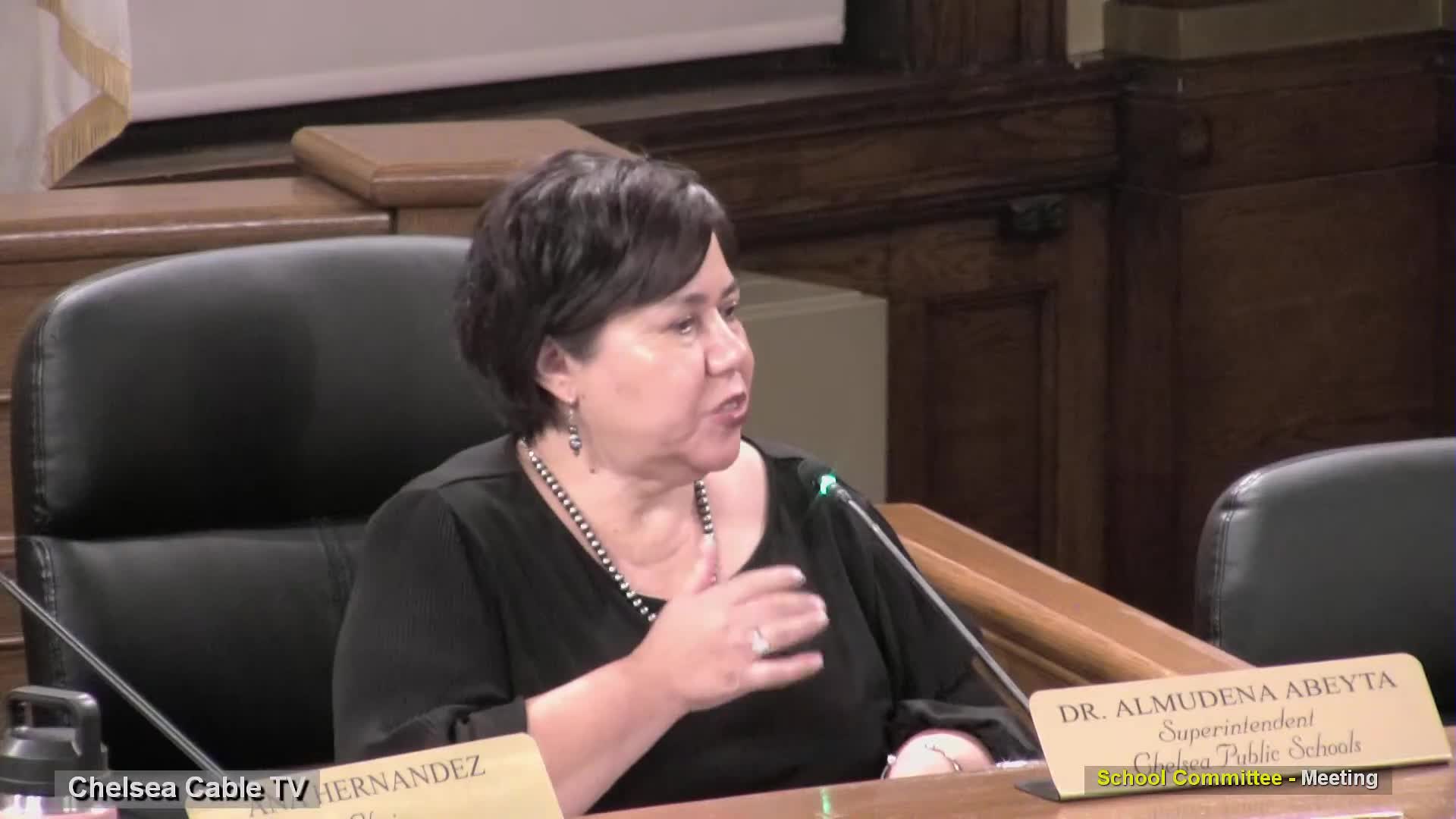Chelsea district posts modest MCAS gains; two schools earn state recognition
October 09, 2025 | Chelsea Public Schools, School Boards, Massachusetts
This article was created by AI summarizing key points discussed. AI makes mistakes, so for full details and context, please refer to the video of the full meeting. Please report any errors so we can fix them. Report an error »

Chelsea Public Schools reported districtwide improvement on state MCAS measures and recognized several schools for academic growth at the school committee meeting on Oct. 8, 2025.
The district said cumulative criterion-referenced growth rose from 39% to 44% between the 2023–24 and 2024–25 reporting years, and that Chelsea is no longer classified by the Department of Elementary and Secondary Education (DESE) as a district needing assistance or intervention.
District officials said the gains were driven largely by elementary grades and progress among multilingual learners, and they singled out Edgar F. Hooks Elementary School and the Berkowitz Elementary School among districts showing substantial year-to-year improvement. The Maurice Segal Clark Avenue School, Joseph Brown Middle School and others were also recognized for growth at the meeting.
"We went from 39% criterion growth to 44%," said Dr. Albeda, the superintendent, summarizing the DESE data slides presented to the committee. "Two schools of recognition back to back is phenomenal and it says that we're doing the right things."
Why it matters: MCAS results and DESE accountability classifications affect district planning, targeted supports and public confidence. Committee members discussed how growth at elementary grades may not yet be reflected at middle grades and noted the continuing effects of student transfers to charter schools.
Officials described the district's strengths and outstanding gaps. Assistant Superintendent Dr. Blake Canty presented three indicators of success tied to the strategic plan: daily attendance, dropout rate and mobility. He said K–8 daily attendance averaged 94%, districtwide attendance averaged 91%, and the current dropout rate stood at about 1%.
"Our dropout rate is declining," Canty said, adding that the district continues outreach before formally dropping students who do not report to school.
Committee members asked for more detail on state accountability measures. In response, district staff explained that DESE sets cumulative criterion targets and accountability percentiles that compare each school with statewide peers. The district noted middle-school dips are a statewide pattern, often linked to transitions and student movement to charter schools.
The committee recognized staff and crossing guards with "Name, Strength, and Story" awards and presented plaques to schools for measurable gains. Dr. Albeda detailed Hooks' double-digit gains on MCAS metrics and praised staff leadership across the district.
Officials also reported enrollment and staffing figures: district enrollment was listed at 5,765 students, down roughly 335 from the prior year, and recent personnel hires reflected the district's diversity goals.
Committee members asked that the district return with further analysis and school-level comparisons so trustees can share clear evidence of academic gains and ongoing needs with families.
Ending: The committee commended the schools and asked staff for follow-up materials on school-by-school academic trends, attendance patterns and the effects of multilingual learner progress on future planning.
The district said cumulative criterion-referenced growth rose from 39% to 44% between the 2023–24 and 2024–25 reporting years, and that Chelsea is no longer classified by the Department of Elementary and Secondary Education (DESE) as a district needing assistance or intervention.
District officials said the gains were driven largely by elementary grades and progress among multilingual learners, and they singled out Edgar F. Hooks Elementary School and the Berkowitz Elementary School among districts showing substantial year-to-year improvement. The Maurice Segal Clark Avenue School, Joseph Brown Middle School and others were also recognized for growth at the meeting.
"We went from 39% criterion growth to 44%," said Dr. Albeda, the superintendent, summarizing the DESE data slides presented to the committee. "Two schools of recognition back to back is phenomenal and it says that we're doing the right things."
Why it matters: MCAS results and DESE accountability classifications affect district planning, targeted supports and public confidence. Committee members discussed how growth at elementary grades may not yet be reflected at middle grades and noted the continuing effects of student transfers to charter schools.
Officials described the district's strengths and outstanding gaps. Assistant Superintendent Dr. Blake Canty presented three indicators of success tied to the strategic plan: daily attendance, dropout rate and mobility. He said K–8 daily attendance averaged 94%, districtwide attendance averaged 91%, and the current dropout rate stood at about 1%.
"Our dropout rate is declining," Canty said, adding that the district continues outreach before formally dropping students who do not report to school.
Committee members asked for more detail on state accountability measures. In response, district staff explained that DESE sets cumulative criterion targets and accountability percentiles that compare each school with statewide peers. The district noted middle-school dips are a statewide pattern, often linked to transitions and student movement to charter schools.
The committee recognized staff and crossing guards with "Name, Strength, and Story" awards and presented plaques to schools for measurable gains. Dr. Albeda detailed Hooks' double-digit gains on MCAS metrics and praised staff leadership across the district.
Officials also reported enrollment and staffing figures: district enrollment was listed at 5,765 students, down roughly 335 from the prior year, and recent personnel hires reflected the district's diversity goals.
Committee members asked that the district return with further analysis and school-level comparisons so trustees can share clear evidence of academic gains and ongoing needs with families.
Ending: The committee commended the schools and asked staff for follow-up materials on school-by-school academic trends, attendance patterns and the effects of multilingual learner progress on future planning.
View the Full Meeting & All Its Details
This article offers just a summary. Unlock complete video, transcripts, and insights as a Founder Member.
✓
Watch full, unedited meeting videos
✓
Search every word spoken in unlimited transcripts
✓
AI summaries & real-time alerts (all government levels)
✓
Permanent access to expanding government content
30-day money-back guarantee

